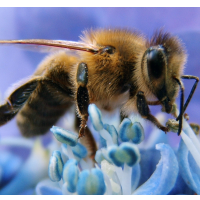Almost One-Third of Honey Bee Colonies in U.S. Collapsed in Just 6 Months

More bad news was released this week about honey bees, which have suffered huge losses in recent years that threaten California’s almond industry.
More than 30% of the honey-bee colonies in the U.S. collapsed this past winter, according to a report by the U.S. Department of Agriculture in collaboration with the Apiary Inspectors of America and The Bee Informed Partnership.
The losses were 42% higher than during the 2011-2012 winter, when 21.9% of colonies died.
California brings in honey bees from around the country for pollination at its almond farms. Almonds are a $3 billion-a-year industry. The Monterey County Beekeepers told Central Coast News that nearly two-thirds of the nation’s bee colonies in the U.S., from as far away as Florida and the East Coast, are shipped to the state.
The beekeepers group estimated that 65% of the bees died this past winter. As the bee population declines, California growers have to spend more money to obtain them, which is reflected in higher food prices.
Experts noted that the latest losses were in line with the average die-off of 30.5% over the past six years. A loss rate of 15% is considered “acceptable,” according to beekeepers, but 70% of the 6,000 beekeepers surveyed in the study cited heavier losses than that.
Bees have been dying in significant numbers in recent years without explanation. The best that experts and the government can do is give the problem a name: Colony Collapse Disorder.
The USDA says the causes could be parasites, disease, genetics, poor nutrition or pesticide exposure. Environmental and beekeeper groups sued the Environmental Protection Agency last March, seeking to ban pesticides that have been found toxic to bees. The European Commission recently announced it will be banning, across the entire continent, three insecticides believed to be killing Europe’s bee colonies: imidacloprid and clothianidin, produced by Bayer, and thiamethoxam, produced by Syngenta.
There are an estimated 2.62 million bee colonies in the United States.
–Noel Brinkerhoff, Danny Biederman
To Learn More:
Preliminary Results: Honey Bee Colony Losses in the United States, Winter 2012-2013 (by Dennis vanEngelsdorp, Nathalie Steinhauer, Karen Rennich, Jeffery Pettis, Eugene J. Lengerich, David Tarpy, Keith S. Delaplane, Angela M. Spleen, James T. Wilkes, Robyn Rose, Kathleen Lee, Michael Wilson , John Skinner , and Dewey M. Caron; Bee Informed Partnership)
Honey Bees Dying Along Central Coast (by Chole Beardsley, Central Coast News)
Honey May Hold the Sticky Solution to Bee Colony Collapse (by Geoffrey Mohan, Los Angeles Times)
Nearly a Third of Honey Bee Colonies Died in U.S. Last Winter (Agence France-Presse)
Beekeepers Sue EPA over Failure to Protect Bees from Pesticides (by Noel Brinkerhoff, AllGov)
Blamed for Bee Population Collapse, Monsanto Buys Bee Collapse Research Group (by Noel Brinkerhoff and David Wallechinsky, AllGov)
- Top Stories
- Controversies
- Where is the Money Going?
- California and the Nation
- Appointments and Resignations
- Unusual News
- Latest News
- California Forbids U.S. Immigration Agents from Pretending to be Police
- California Lawmakers Urged to Strip “Self-Dealing” Tax Board of Its Duties
- Big Oil’s Grip on California
- Santa Cruz Police See Homeland Security Betrayal in Use of Gang Roundup as Cover for Immigration Raid
- Oil Companies Face Deadline to Stop Polluting California Groundwater





